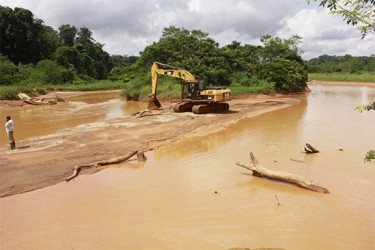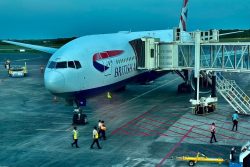Mining and environmental protection officials will soon visit the Konawaruk River to check on its state and an assessment is needed to determine whether the river is supporting aquatic life, Minister of Natural Resources and the Environment Robert Persaud has said.
The minister acknowledged that the Region Eight (Potaro/Siparuni) river has been degraded by mining activities and said that action can be taken to help the river recover. “With proper management of tailings by miners, constant monitoring and enforcement by GGMC [Guyana Geology and Mines Commission] and EPA [Environmental Protection Agency], the river can recuperate. If required as a last resort, targeted/direct environmental restoration has been done in many other places, including restoration of rivers and biodiversity. If the situation warrants it, we are sure it can be done here as well,” the minister said.
Stabroek News reported earlier this month that the Konawaruk River is still heavily silted more than a decade after attention was first drawn to the degraded state of the waterway. It had previously been branded a “dead” river – incapable of supporting aquatic life but this has drawn varying views. “It would be difficult to say that without carrying out a proper assessment,” Dr David Singh, the head of Conserva-tion International – Guyana had said. He had pointed out that the period for which the river has remained in a heavily polluted state -10 to 15 years – is more than the lifespan of aquatic species.

Former head of the GGMC William Woolford, who is now a consultant in the mining industry, however, was adamant that the Konawaruk River is not dead. And Major General (rtd) Joseph Singh, who first expressed concern about the state of the river over a decade ago, has said that there is need for a technical evaluation to determine the extent of the damage to the Konawaruk River.
In a response to the Stabroek News articles, Persaud said that the claims of the state of the Konawaruk River are of concern to him. The accuracy of these claims would need to be ascertained through the GGMC and EPA, he said.
“Whether the [Konawaruk] River is supporting aquatic life needs to be assessed. No recent studies have been conducted nor are recent scientific data available,” Persaud said. He noted that the last known assessment might have been carried out by RESCAN Consultants Inc, a Canadian firm, in 1994. “RESCAN was to have independently provided an unbiased assessment of the existing environmental conditions for the then Mazda mining operations. The proposed assessment mentioned biological monitoring; however, this data cannot be immediately sourced,” the minister said. Nonetheless, the EPA is pursuing measures to find if any of this data is available, he asserted.
Persaud said the EPA and GGMC will coordinate another visit “very shortly” to update on the status of the river and advise accordingly.
The minister added that at present there are personnel from the GGMC’s Mines Inspectorate and the Environ-mental Division who are monitoring the mining operations within the drainage basin of Konawaruk River. Monitoring and technical assistance to miners will be continued in the Konawaruk area to address mining and environmental issues, he added.
Working with mining operations
Persaud said the GGMC has been working with mining operations in the area to reduce their tailings impact on the Konawaruk River. “The EPA and GGMC have always advocated the importance of mining in a sustainable manner to minimise or prevent negative impacts on our environment. Both the EPA and GGMC have progressively monitored and taken action through enforcement, issuing of Cease Work Orders (CWO) and charges and providing technical assistance to mining operations in the Konawaruk area. The GGMC in fact placed a sub-mining station at Mowasi to ensure more active monitoring in the Konawaruk area,” he stated, adding that to say that nothing was done is incorrect.
In giving a short history of the area, Persaud said the issue of the degraded state of the Konawaruk River had engaged the attention of GGMC and the EPA since 2000, but particularly so when the media highlighted a claim by residents of Monkey Jump and other surrounding areas that Omai Gold Mines Ltd was discharging effluent into the Essequibo River.
The EPA conducted rapid water quality assessment expeditions to the areas in question – Konawaruk, upstream Omai areas and the Essequibo River upstream to Konawaruk, inclusive of the Tiger Creek in the Potaro River – he recounted.
Persaud said the results indicated that mining activities within these areas were contributing to the pollution of the rivers, particularly that of the Konawaruk on to the Essequibo. Turbidity (total suspended solid levels) at the time was above the limit of 30 NTUs (turbidity units) set out in the Guyana Mining Regulations, particularly in the Konawaruk and at the point where it meets the Essequibo. “This high turbidity was causing alarm to residents in the surrounding areas. However, if was recognised that it was heavy rainfall that increased the turbidity, and not that of OGML discharging effluent into the river as was claimed. The EPA continued monitoring the Konawaruk until February 2002. EPA permits large scale mining operations – there were none permitted within the vicinity of this area,” Persaud said.
The minister said the GGMC has continued to monitor the situation, and with particular increased intensity since 2010 when it conducted a major exercise to reduce the level of turbidity along the Konawaruk River. “The Lower Konawaruk in particular was identified as one of the locations where the turbidity was cited to be above the critical limit of 30 NTUs,” he revealed.
Persaud said that the goal of that GGMC exercise was to reduce the turbidity in the Konawaruk River to the acceptable limit of 30 to 50 NTUs. All potential offenders with regard to turbidity would be issued with CWOs pending rectification of the breaches committed. Further, technical assistance would be provided as would education and awareness as it pertains to tailings management, he said.
North America Resources Limited
The minister recounted that the GGMC’s findings revealed that the mining company, North America Resources Limited (NARIL) was the major contributor to the high level of turbidity. A follow-up of the area after the exercise was completed showed that the turbidity levels were reduced, he said.
Persaud recounted that in November – December 2010, a study of turbidity and suspended solids in the Konawaruk River Basin in relation to small and medium-scale gold mining was done by the GGMC’s Environmental Division. “General observations from the water quality testing of the Konawaruk River found that higher total suspended solids and turbidity with corresponding high sediment yield was found downstream of mining operations, particularly higher levels below NARIL,” he said.
As such, the GGMC required the company to implement abatement measures. In March 2011, the GGMC received a plan on behalf of NARIL titled ‘Konawaruk Tailings Abatement Activity and Work Plan.’ The plan outlined the construction of a tailings management facility (including a dam across the Konawaruk River) and the use of coagulants and flocculants to abate the high levels of turbidity in the river, he stated.
“GGMC promptly visited NARIL’s Konawaruk operations to document activities and experiences at NARIL up to March 14, 2011 and provide information to assist in determining steps to be taken to reduce turbidity in the Konawaruk River,” Persaud said. He recalled that Prime Minister Samuel Hinds on a visit to the NARIL site on March 13, 2011 was brought up to date with recent activities at the site in the search for solutions to the turbidity problem. Following the visit, Hinds, who was the minister with responsibility for mining at the time, approved a three-month period of operation and study for this purpose, Persaud said.
A month later, in April 2011, a meeting was held in the office of the manager of the GGMC’s Mines Division to discuss the Konawaruk Tailings Abatement Activity review and Work Plan, prepared by NARIL. The review agreed that NARIL would contain and treat its tailings to ensure that discharge was within stipulated limits. Also, NARIL was required to conduct reclamation of existing rivers banks, the minister recounted.
“The reports have shown that NARIL operations in the Konawaruk River were the major contributor to the high levels of turbidity in the river. However tailings discharge from other mining operations upstream and downstream of the NARIL operations contributed to the high levels in the river,” he said.
“Mining is important to livelihoods of many and the economy as a whole in Guyana. As Minister of Natural Resources and Environment I believe that it is possible to find the balance between natural resource use and environment conservation,” Persaud said. He asserted that his ministry has always expressed the view that while the people benefit from Guyana’s resources, they must be mindful of the environment. “We are already working [through GGMC] with mining operations towards minimising the impact on the environment,” he declared.






